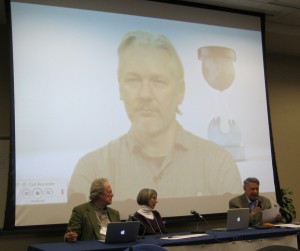
By Lori Andrews
On April 15, the U.S. Supreme Court will hear the case Association of Molecular Pathology v. Myriad. The question before the court is: Are human genes patentable?
For 150 years, the Supreme Court has said that abstract ideas, laws of nature and products of nature are not patentable. Such patents would run afoul of the progress clause of the Constitution and section 101 of the Patent Act.
In 1980, the Supreme Court in Diamond v. Chakrabarty held that genetically modified living organisms are patentable if they are markedly different than what occurs in nature. That case reiterated that laws of nature like E = mc2 are not patentable, nor are products of nature such as plants from the wild or minerals from the ground.
Three decades after the Chakrabarty decision, the Supreme Court revisited the exception by taking a trilogy of cases. In the first one, Bilski v. Kappos, the Court held that an abstract idea–hedging in trading energy futures–could not be patented. In Mayo v. Prometheus, the Court held 9-0 that a law of nature–how the body responded to the administration of a drug–was not patentable.
 In the Myriad case, the Court will be addressing the third part of the exception, dealing with products of nature. It will address whether an “isolated” breast cancer gene is an unpatentable product of nature. The patents at issue cover two isolated genes related to breast cancer, BRCA1 and BRCA2. The patents define the isolated gene to include a gene sequence “removed from its naturally occurring environment.” This claim gives Myriad the ability to control all uses of anyone’s breast cancer genes once they are removed from the body, giving Myriad the right to exert a monopoly over all BRCA1 and BRCA2 breast cancer gene testing and research.
In the Myriad case, the Court will be addressing the third part of the exception, dealing with products of nature. It will address whether an “isolated” breast cancer gene is an unpatentable product of nature. The patents at issue cover two isolated genes related to breast cancer, BRCA1 and BRCA2. The patents define the isolated gene to include a gene sequence “removed from its naturally occurring environment.” This claim gives Myriad the ability to control all uses of anyone’s breast cancer genes once they are removed from the body, giving Myriad the right to exert a monopoly over all BRCA1 and BRCA2 breast cancer gene testing and research.
What is a gene sequence? It’s a series of chemical letters known as nucleic acid bases–designated by A, T, C, and G. It is important because a single change in the letter–a typo in the sequence–can lead to a genetic disease. To diagnose a genetic disease, a physician or laboratory compares the patient’s genetic sequence to a normal gene sequence to see if there are differences that predispose the patient to breast cancer.
The question the Supreme Court will ask, under the Chakrabarty case, is whether what Myriad patented is “markedly different” from the breast cancer genes in the body. Myriad asserts that the isolated gene is a product of human ingenuity. Myriad argues that it “successfully isolated the ‘BRCA’ molecules and disclosed their creation to the world. This momentous advancement required significant skill, insight, and invention on the part of Myriad’s inventors.”
Myriad also argues that isolation of the gene “depended on an enormous amount of human judgment, including how to define the beginning and end of what came to be called the BRCA1 and BRCA2 genes, and then creating isolated DNA molecules corresponding to those particular defined genes.” Myriad also argues that by isolating the gene, it gave the gene new uses since genes in the body cannot be used for diagnosis. It also created copies of the gene in the lab.
In contrast, the petitioners in the case argue that what Myriad patented is not markedly different from nature. For Myriad’s gene sequence to work as a diagnostic tool, it must have the identical sequence to that of a breast cancer gene in nature. The petitioners argue that once the unpatentable product of nature, the gene sequence, was discovered, Myriad used routine means to create copies of it and to undertake diagnostic comparisons to patients’ genes. The Court is likely to look to a 1948 Supreme Court case, Funk Brothers Seed Co. v. Kalo Inoculant Co., in which the patent applicant combined six types of bacteria and the claimed invention was found to be an unpatentable product of nature because the bacteria “served the ends nature originally provided.” The petitioners argue that here the isolated gene sequence merely serves the ends nature intended.
In addition to extensive briefing about whether there is sufficient human ingenuity involved to consider an isolated human gene to be a patentable invention, the affidavits and amicus briefs in the case gathered all existing data on whether gene patents encourage or discourage innovation. Over 90 affidavits were filed, including those from Nobel Laureates. Briefs from over 102 amicus groups were filed, including briefs from medical organizations such as the American Medical Association and patient advocacy groups such as the March of Dimes arguing for the invalidation of gene patents, and briefs from industry organizations such as the Biotechnology Industry Organization and intellectual property associations such as the American Intellectual Property Law Association arguing that gene patents are valid. Also weighing in were prominent scientists, various companies and numerous law professors.
I filed an amicus brief in the case on behalf of medical organizations, including the American Medical Association, American College of Obstetricians and Gynecologists, and American Society of Human Genetics, providing evidence that patents on genetic sequences interfere with health care and research.
Medical organizations are concerned because gene patents increase the cost of the diagnosis and treatment of genetic diseases. For 20 years, a gene patent holder controls any use of “its” gene. The patent holder can charge whatever it wants for any test analyzing the patented gene–even if that test uses a technology that was not invented by the patent holder. Myriad, which holds the patent on the BRCA1 and BRCA2 genes, charges over $3,000 for its genetic test for breast cancer. One in four laboratories has stopped performing certain genetic tests because of patent restrictions or excessive royalty costs.
The ability of a patent holder to prevent health care providers from using a patented genetic sequence denies people crucial medical information. Most drugs only work on a percentage of patients who use them. An asthma inhaler might only work on seven of ten people to whom it is prescribed, causing the other three to suffer symptoms of asthma and pay for an inappropriate drug until the right medication can be found. Genetic testing can help to distinguish those people for whom a drug will work from those people for whom it will not work, but, if the same entity holds the patents on the drugs and the gene sequences, it may prevent use of the gene sequence because the identification of people for whom the drug will not work will limit the market for the drug.
One company has filed for patent protection on a genetic sequence that could be tested to determine the effectiveness of its asthma drug in a prospective patient. The company, however, has said that it will not develop the test–or let anyone else develop the test. While such a test would be crucial to doctors in determining which patients would benefit from the use of the asthma inhaler and which patients would benefit from a different drug or treatment, it would also diminish the market for the drug because a trial use of the asthma inhaler would no longer be needed to know if it would be an effective treatment.
For more information, listen to my interview with Minnesota Public Radio on the subject or view the video of an interview with me on the OYEZ website.








 In the Myriad case, the Court will be addressing the third part of the exception, dealing with products of nature. It will address whether an “isolated” breast cancer gene is an unpatentable product of nature. The patents at issue cover two isolated genes related to breast cancer, BRCA1 and BRCA2. The patents define the isolated gene to include a gene sequence “removed from its naturally occurring environment.” This claim gives Myriad the ability to control all uses of anyone’s breast cancer genes once they are removed from the body, giving Myriad the right to exert a monopoly over all BRCA1 and BRCA2 breast cancer gene testing and research.
In the Myriad case, the Court will be addressing the third part of the exception, dealing with products of nature. It will address whether an “isolated” breast cancer gene is an unpatentable product of nature. The patents at issue cover two isolated genes related to breast cancer, BRCA1 and BRCA2. The patents define the isolated gene to include a gene sequence “removed from its naturally occurring environment.” This claim gives Myriad the ability to control all uses of anyone’s breast cancer genes once they are removed from the body, giving Myriad the right to exert a monopoly over all BRCA1 and BRCA2 breast cancer gene testing and research.